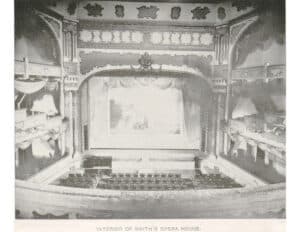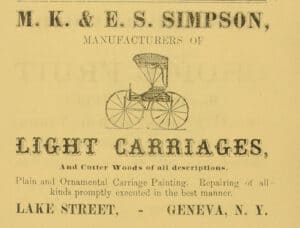On the Importance of City Directories
By Becky Chapin, Archivist
Of interest to researchers and genealogists, but probably not to today’s population, are city directories, the predecessor of the phone book. City directories are an incredible source of information prior to about the 1970s when the phone book became the more popular name. Earliest city directories date from the 16th century, but there were few and far between until the 18th century. The first publication of a printed directory in an American city appeared in a Baltimore newspaper that included a listing of the inhabitants written by “A Lady of Respectability” in 1752. The first separately published directory appeared on November 16, 1785 in Philadelphia with another published 13 days later, though not as detailed.
New York City followed shortly after with its first directory in 1786 and several more were published in the 18th century. Street directories were few and far between in NYC until the 1920s, but Geneva’s directories included alphabetical and street number listings from 1894 with business listings added later on.
The first phone book was published on February 21, 1878, less than two years after Alexander Graham Bell invented the telephone. That first ‘book’ was a single sheet of paper which listed the fifty people and businesses who had a telephone in New Haven, Connecticut. In fact, most people preferred speaking to a switchboard operator until well into the 20th century instead of dialing the number themselves.
Directories are my first stop in research when looking into people, businesses, and streets in Geneva. We were lucky enough to have had a fairly regular annual or biennial publication from 1894, the year the building numbers in Geneva were changed to what we have today. Maps of Geneva (though sparse) are sometimes useful in identifying which buildings correspond to the numbers prior to the change (unfortunately an index to the changes has not yet been found).

A side by side comparison of Geneva city directories over 50 years.
Before 1894, there were very few city directories published; the surviving years include about eight books published from 1855 to 1892. As the population grew, the books grew in size and in information given. The early directories are sometimes unhelpful, such as failing to list a building number with the street name, but they do list occupations, business address, and home address. Names of wives were left out unless they were a widow or owned a business. In later years their names appeared in parenthesis before being listed on their own. Phone books then began listing spouses on the same line again and in the late 20th century, first names for most people were shortened to a first letter, though occupations were no longer listed.

Excerpt from city directory showing RFD #5 listings but no street numbers. Except from City Directory
Geneva’s city directories are notoriously unhelpful when looking for people who lived in the town of Geneva- it’s obvious in the name. There are very few times that I have been able to successfully identify where a family lived in the town, as even into the 1950s the names are listed as living on “RFD 1” or “RFD 4.” Even before then, it was rare to even have a town person in the directory at all unless they operated a business in the city.
City directories have their pros and cons, but they are one of the most important sources of information when looking at family or business movements over time. Want to identify which house a family photo was taken in front of? Consult the directory. Want to know where your grandfather worked? Consult the directory.

An interior look at the Smith Opera House during its first year. The photo was taken from the balcony showing the stage and boxes on the sides that are no longer there.
The earliest image of the Smith Opera House interior can be found in the 1895 directory, advertisements for businesses are very interesting and often provide images of their merchandise which may otherwise be lost, plus homeownership, boarding, and business name or position is noted by each name.
The decline in phone book usage in the past few decades could have consequences in the fields of research and genealogy in the future. Concerns about privacy and a decline in landlines means that phone books today consist mainly of business listings and no people.
Every day we make history. You made history yesterday, and you will tomorrow. How do you leave behind your story for your descendants? Be consistent in your recordkeeping, label photos with dates and names plus locations, label your digital folders and files appropriately, leave your archives to a historical society (like us!), and leave instructions on how your descendants should take care of what you leave behind.
And if you have any questions about how to take care of your personal papers, how we handle donations, or alternatives to donating your treasures, send me an email at archivist@genevahistoricalsociety.com.


Geneva city directories have been a wonderful and valuable source of both family and Geneva history to me for decades. Ancestry.com has a significant selection of Geneva city directories that I have been able to use to research generations of my family and occasionally a family friend or neighbor. Not living in NY state, these are a godsend. And you are so right, their demise and the lack of source materials for such information will make research much more difficult in the future. Online white pages or online research firms are not the same.
I love doing research. Old phone books are fascinating. Especially the names of companies that no longer exist. I remember Patent Cereals in Geneva and also a radiator factory. Noah’s Arc was also an important store, and I loved Matello’s second hand store. My father, Harold Nester, and later my mother, Doris Nester owned the Exchange Building at 435 Exchange Street. I lived in an apartment there on weekends when I visited from Rochester. I worked for Eastman Kodak as a Film Editor. My mother lived in Geneva and also New York City. Glad old phone books have been saved.